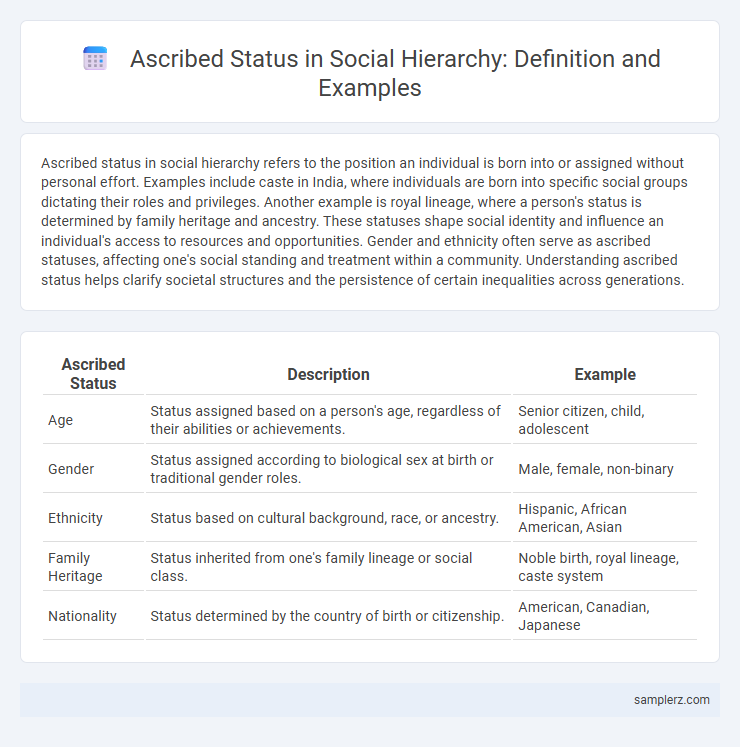Ascribed status in social hierarchy refers to the position an individual is born into or assigned without personal effort. Examples include caste in India, where individuals are born into specific social groups dictating their roles and privileges. Another example is royal lineage, where a person's status is determined by family heritage and ancestry. These statuses shape social identity and influence an individual's access to resources and opportunities. Gender and ethnicity often serve as ascribed statuses, affecting one's social standing and treatment within a community. Understanding ascribed status helps clarify societal structures and the persistence of certain inequalities across generations.
Table of Comparison
| Ascribed Status | Description | Example |
|---|---|---|
| Age | Status assigned based on a person's age, regardless of their abilities or achievements. | Senior citizen, child, adolescent |
| Gender | Status assigned according to biological sex at birth or traditional gender roles. | Male, female, non-binary |
| Ethnicity | Status based on cultural background, race, or ancestry. | Hispanic, African American, Asian |
| Family Heritage | Status inherited from one's family lineage or social class. | Noble birth, royal lineage, caste system |
| Nationality | Status determined by the country of birth or citizenship. | American, Canadian, Japanese |
Understanding Ascribed Status in Social Hierarchies
Ascribed status in social hierarchies refers to the fixed social positions assigned at birth, such as caste, ethnicity, or royal lineage. These statuses influence individuals' roles, privileges, and social mobility within society, often independent of personal achievements. Understanding ascribed status highlights the impact of inherited traits on social stratification and power dynamics.
Common Examples of Ascribed Status in Society
Common examples of ascribed status in society include race, gender, and family heritage, which individuals receive at birth without personal choice. These statuses often influence social hierarchy by determining access to resources, opportunities, and power. Ethnicity and caste also serve as critical ascribed statuses that shape societal roles and expectations.
The Role of Family Background in Determining Status
Family background significantly influences ascribed status by shaping an individual's position in social hierarchies from birth. Factors such as parental wealth, education, and occupation often determine access to resources and opportunities, reinforcing social stratification. This inherited status impacts lifelong social mobility and the ability to attain achieved statuses.
Gender as an Ascribed Social Position
Gender functions as a fundamental ascribed status in social hierarchies, shaping individuals' roles, expectations, and access to resources from birth. It influences power dynamics and social stratification by assigning positions based on biological and cultural characteristics rather than personal achievements. This gender-based social positioning affects opportunities in education, employment, and political participation, reinforcing systemic inequalities.
Ethnicity and Its Impact on Social Ranking
Ethnicity significantly influences ascribed status within social hierarchies by assigning individuals a fixed position based on inherited cultural traits and ancestry. In many societies, ethnic background determines access to resources, political power, and social privileges, often perpetuating systemic inequalities. This rigid classification reinforces social stratification, making ethnicity a critical factor in unequal social ranking.
Citizenship and Nationality as Ascribed Identifiers
Citizenship and nationality serve as fundamental ascribed statuses that define an individual's position within social hierarchies by assigning identity based on birth or descent rather than personal achievement. These identifiers influence access to rights, privileges, and social opportunities, often shaping societal inclusion and exclusion. Governments use nationality to enforce legal status and civic responsibilities, solidifying hierarchical distinctions within and between nations.
Age-Based Hierarchies in Social Structures
Age-based hierarchies assign social status according to individuals' age, often granting elders higher authority and respect within communities. In many traditional societies, older adults hold decision-making power and influence over resources, reinforcing their dominant position in the social structure. This ascribed status based on age persists in various cultural and organizational contexts, shaping roles and expectations across generations.
The Influence of Social Class at Birth
Social class at birth significantly shapes an individual's ascribed status in society, determining access to resources, education, and social networks from an early age. Children born into affluent families often inherit privileges that maintain or enhance their social position, while those from lower socioeconomic backgrounds face systemic barriers limiting upward mobility. This inherited social class creates a persistent hierarchy, influencing life chances and societal roles regardless of personal achievements.
Religion and Its Role in Ascribed Status
Religious affiliation often serves as a crucial ascribed status within social hierarchies, determining individuals' roles and privileges based on birth rather than personal achievement. For instance, in caste-based societies like India, one's religion significantly influences social stratification and access to resources. This inherent religious identity shapes not only social interactions but also institutional power dynamics and community belonging.
Caste Systems as Traditional Ascribed Hierarchies
Caste systems exemplify traditional ascribed hierarchies where social status is inherited and fixed at birth, limiting mobility across generations. Individuals are assigned roles, occupations, and social privileges based on their caste, deeply influencing social interactions and access to resources. These rigid structures reinforce inequality and social stratification within communities.

example of ascribed status in hierarchy Infographic
 samplerz.com
samplerz.com